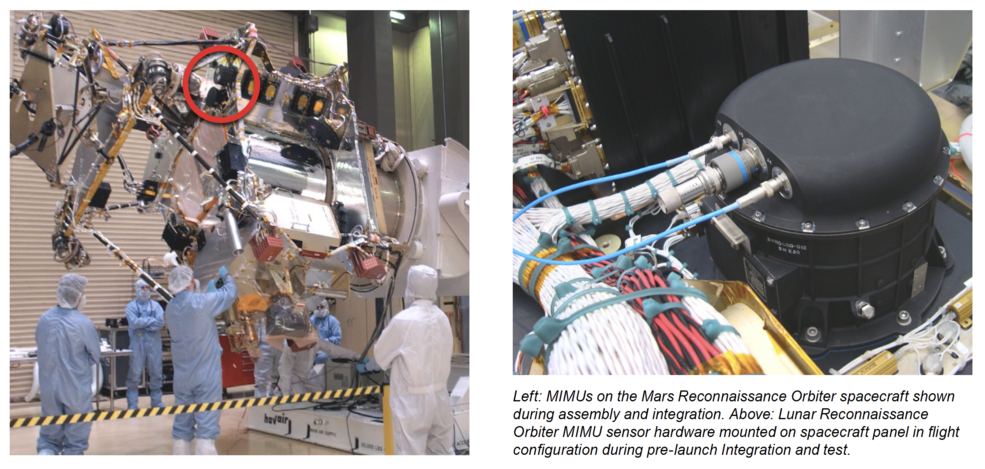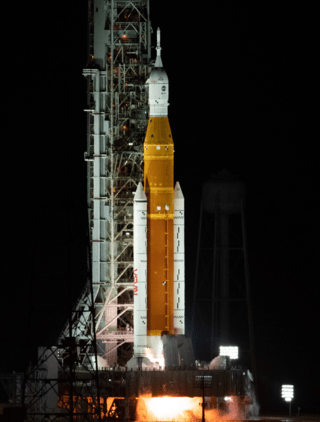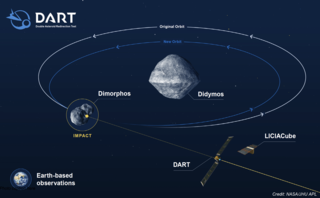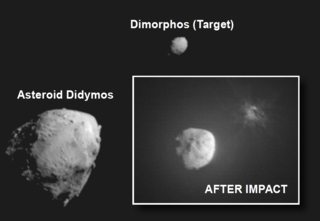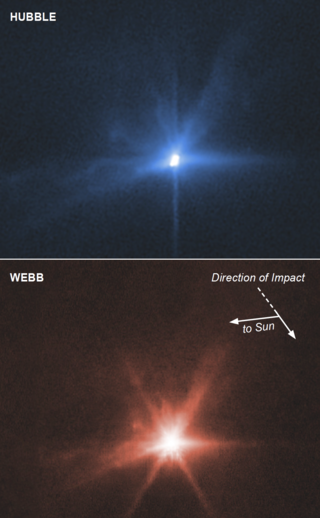The NESC GNC Technical Discipline Team (TDT) conducted numerous activities in the course of 2022 in support of the NASA Mission Directorates. Discussed below are three noteworthy highlights and a look into the future of the GNC discipline at NASA.
This article is from the 2022 NESC Technical Update.
The NESC GNC Technical Discipline Team (TDT) conducted numerous activities in the course of 2022 in support of the NASA Mission Directorates. Discussed below are three noteworthy highlights and a look into the future of the GNC discipline at NASA.
Extending Inertial Measurement Unit Operational Lifetime Study
Inertial sensors provide the foundation for the GNC systems on most of NASA’s spacecraft. Inertial measurement units (IMU) are highly-integrated assemblies of inertial sensors, including gyroscopes to measure angular motion/rates, accelerometers to measure translational forces, and associated electronics. One such spacecraft IMU is the Miniature Inertial Measurement Unit (MIMU), produced by Honeywell International Inc., which employs ring laser gyroscope (RLG) inertial sensor technology. The MIMU is a workhorse sensor commonly used on NASA spacecraft that fly in operational regimes ranging from low Earth orbit to planetary and deep space. It is a fully self-contained three-axis strapdown, radiation-hardened sensor system that provides inertial reference data to the spacecraft’s onboard GNC systems for maintaining precise orbit/trajectory control and payload instrument orientation.
Framing a Suspected Temperature Issue
There have been indications that the MIMU lifetime is operating temperature-dependent. Thus, the Space Science Mission Operations (SSMO) organization at GSFC requested the NESC to determine any best practices that could maximize the MIMU operating life. The SSMO is the key stakeholder, along with Exploration Systems Development and Space Operations Mission Directorates. In response, an NESC team performed the MIMU Operational Life Investigation,1 to achieve two goals: formulate recommendations for MIMU operational best practices for spacecraft mission operations teams, and capture best practices for GNC design teams for accommodating/integrating the MIMU sensor hardware into spacecraft.
MIMU Data Collection, Analysis, and Modeling
Confirming the suspected temperature dependence was challenging since MIMU flight data have been retained within programs and projects, which limits the ability to analyze systemic operational performance. In spite of the challenges, the NESC team collected an extensive set of MIMU operational flight data from 12 different NASA space missions, selected to obtain data over a wide range of operating regimes (e.g., Earth orbiting, lunar orbiting, Mars orbiting, deep space), operational usage, and primary mission durations. The team analyzed the collected data sets to identify trends or patterns of successful MIMU operation. Open literature covering RLG inertial sensor technology was also studied to understand both laser failure modes and failure mechanisms of neon depletion within RLGs.
A primary discovery is that MIMU RLG laser intensity monitor (LIM) telemetry, which is a direct measure of RLG laser optical power, is the fundamental indicator of gyroscope health and should be monitored and trended from each of the three RLGs during the mission. The flight data from multiple missions indicated that the MIMU LIM telemetry measurements vary over time in direct relation to the RLG operating temperature.
A model using a linear curve fit has been developed by JPL flight operations analysts and can be used to estimate the relationship of RLG operating temperature versus RLG LIM. This leads to a direct temperature detrending approach where a given average RLG operating temperature is assumed, removing the LIM effect due to temperature fluctuations. In general, detrending removes the effects of a trend from a data set, revealing differences from any long-term direction, allowing periodic or other patterns to be identified.
Temperature-detrended LIM data typically show a period of increasing value followed by an inflection point where the time rate-of-change (i.e., the slope of the LIM curve) becomes increasingly negative, eventually leading to a critical end-of-life (EOL) point where the RLG lasing ceases and the inertial data are not usable for GNC algorithm processing. Calculating the derivative of the smoothed temperature detrended LIM can be used to alert spacecraft operators that the temperature-corrected LIM has begun to trend downward toward a potential EOL condition.
MIMU Findings and Recommendations
Based on the collected data and the detrend modeling effort, the team found the RLG lifetime remains static and does not degrade if the unit is powered off for long periods (e.g., months). Additionally, it is critically important for spacecraft mission operators to monitor and detrend the LIM telemetry from each of the three RLGs in a given operating MIMU device to assess the LIM telemetry over time. But it does not yet appear possible to precisely predict when the LIM EOL inflection point will occur as a function of MIMU operating hours.
An important finding is that several missions examined in this study have developed and operationally implemented the use of an all-stellar (i.e., gyroless) or stellar-only attitude determination algorithm/flight software update to preserve MIMU (or any other IMU) operating life for essential attitude control and navigation operations. In conclusion, this large MIMU flight data set and modeling performed by the team can serve as a valuable resource for NASA to build upon for future examinations of MIMU performance by GNC engineers.
NESC Technical Bulletins Published on Launch Vehicle Flight Control Stability
The GNC TDT invested significant time and energy to capture the best practice knowledge that emerged from a recent NESC GNC assessment concerning launch vehicle stability.2 The TDT generated two NESC technical bulletins to capture these best practices.
The first focused on Launch Vehicle Flight Control Stability Margin Reduction Considerations3 outlining industry standard stability margin best practices. It also provided recommendations for the treatment of deviations from these standard launch vehicle stability margins due to vehicle flexibility, slosh dynamics, aerodynamics, and other undesired dynamics or coupling.
The second bulletin captured best practices for the Treatment of Slosh Stability Margin Reductions for Human-Rated Launch Vehicles.4 Propellant slosh dynamics pose a stability concern for human-rated launch vehicles during ascent. The bulletin provides historical perspectives on the treatment of launch vehicle slosh dynamics along with some newly developed rules of thumb and observations concerning the utility of flight data. Furthermore, it outlines several methods for analyzing and dispositioning slosh instability risks that should be considered when launch vehicle flight control linear stability margins are lower than typically accepted for human-rated systems.
Successful Planetary Defense Test
Members of the GNC TDT provided specialized technical support to the successful asteroid-impacting Double Asteroid Redirection Test (DART) mission performed by the Johns Hopkins University (JHU) Applied Physics Laboratory (APL)5.
Mitigating the Risk of Star Tracker Noise
The NESC supported multiple risk reviews including a star tracker sensor noise sensitivity evaluation as part of the prelaunch Flight Readiness Review. The DART spacecraft required accurate attitude knowledge during its terminal phase (i.e., the final 4 hours of the mission) to ensure asteroid intercept. The star tracker sensor on DART provided fundamental spacecraft attitude measurements that were critical to the performance of the on-board SmartNav optical guidance system used to target the asteroid. Prior to launch, it was identified that DART’s asteroid impact performance was very sensitive to star tracker sensor noise. The GNC TDT evaluated the DART star tracker noise sensitivity during the terminal asteroid intercept phase of the mission and participated in in-depth technical reviews of the DART star tracker noise model used in the simulation of impact performance. They worked closely with APL GNC engineers to review in-flight star tracker data collected from another mission flying a similar star tracker. It was observed that impact performance was not sensitive to sensor white noise, but rather to time-correlated noise (i.e., random walks).
The NESC subject matter experts pointed out the criticality of focusing on revising the time-correlated features of the star tracker noise model. This emphasis was necessary given the DART spacecraft’s on-board attitude determination filtering was not able to significantly reduce these time-correlated random walks. Updating the star tracker noise model was necessary to ensure the most accurate simulation-based predictions of the orientation and motion of the spacecraft during the terminal phase just prior to impacting the asteroid. The NESC performed a prelaunch risk evaluation and recommended that the DART GNC team cease any further noise model changes until actual in-flight star tracker calibration data could be obtained from the spacecraft and analyzed. The NESC also encouraged the flight operations team to perform opportunistic optical navigation tests prior to the actual asteroid intercept phase to evaluate the influence of star tracker sensor noise under realistic conditions.
Solar Array Dynamics Modeling and Simulation
Prior to launch, the NESC provided technical support to perform a quick-response risk assessment of a late-occurring DART spacecraft solar array dynamics issue. A multi-disciplinary NESC team from the GNC and Loads and Dynamics TDTs considered the technical issue, performed sufficient modeling and simulation of the solar array dynamics, and provided APL with independent flight rationale for proceeding with the launch.
Results
The NESC was pleased to support the DART mission demonstration of planetary defense. One week after the September 26 impact, the orbital period of Dimorphos around its parent body, Didymos, had decreased from 11 hours and 55 minutes to 11 hours and 23 minutes, indicating the kinetic impact successfully altered the asteroid’s orbit.
Looking Ahead for the GNC Discipline
The mission-pull demand for more autonomous operational capabilities is on the rise across all NASA’s Mission Directorates. Consequently, the GNC TDT has adopted “Autonomous GNC” as its strategic vector providing the team a future focus on the system architectures, technologies, and engineering methods for implementing autonomous capabilities. As part of its annual assessment of the GNC discipline’s state of health, the TDT has observed that aerospace GNC systems are growing more complex. To address this “curse of complexity,” the TDT has identified the strategic need for the GNC discipline to enhance its ability to support more complex system interfaces and dynamic interactions. For example, current verification and validation (V&V) approaches and processes are not adequate to cope with the evolving GNC architectures and topologies being driven by autonomy. The TDT is currently working to understand where the existing gaps are in NASA’s V&V capability and to prioritize tool and method development needs for V&V of advanced GNC algorithms. The next generation of GNC engineers at NASA will need to create robust and resilient system architectures that structure and integrate emerging technologies (e.g., for autonomous onboard maneuvering) across multiple disciplines. These engineers will need to be equipped with modernized design methods and tools that allow the convergence of a multidisciplinary design-optimization process. Model-based design synthesis approaches that can simultaneously satisfy multiple dynamic system stability and performance requirements will likely be at the heart of the solution process for future autonomous GNC systems.
- Miniature Inertial Measurement Unit (MIMU) Operational Life Investigation, June 2022. NASA/TM-20220012239
- NESC Report “Treatment of Launch Vehicle Flight Control Stability Margin Reductions for Crewed Missions with Emphasis on Slosh Dynamics,” June 2022.
- NESC Technical Bulletin No. 22-05, “Launch Vehicle Flight Control Stability Margin Reduction Considerations,” August 2022.
- NESC Technical Bulletin No. 22-06, “Treatment of Slosh Stability Margin Reductions for Human-Rated Launch Vehicles,” August 2022.
- NESC Support of Double Asteroid Redirection Test (DART) Mission.




























